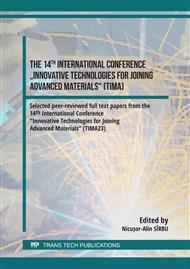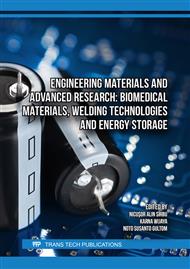p.3
p.11
p.23
p.33
p.43
p.51
p.57
p.65
Experimental Studies of Corrosion Resistance of Welded Seams of Steel Structures with a High Sulfur Content in Surface Layers Using Modern Methods of Modeling
Abstract:
Analysis of literature sources and empirical data indicate a variety and a large volume of experimental material, which often characterizes the uncertainty and contradiction of information regarding the effect of sulphur and manganese on the corrosion behaviour of steels obtained using traditional methods. This leads to the need to search for new, alternative methods for its effective analysis. The task of assessing and predicting the corrosion properties of structural steels is a key one in the general problem of managing the operational reliability of welded metal structures and equipment for the chemical, metallurgical, oil and gas, mining and other industries. The possibilities of its solution consist of using new information technologies, a component of which is intelligent means of information processing, such as artificial neural networks (ANN). The use of ANN makes it possible to create qualitatively new hardware and software that significantly expand the classes of emerging problems and increase the efficiency of analysis and forecasting. In the process of long-term operation of metal structures in many industrial industries, the metal is in direct contact with sulfur-containing agents at high temperatures. This leads to the saturation of the surface layer of the metal with sulfur with a concentration of up to 0.6%, which further makes it impossible to carry out repair and welding operations due to the formation of hot cracks. It was found that adding metallic manganese into the electrode coating in an amount of 20-25% significantly increases (4-5 times) the resistance against the formation of hot cracks. Sulfur content in the deposited metal has the opposite effect on the appearance of hot cracks. So, with a sulfur content of 0.042% and more, the resistance of the metal against the formation of hot cracks decreases sharply. It is shown that an increase in the content of metallic manganese in the electrode coating significantly reduces the content of dissolved sulfur in the deposited metal. Moreover, this tendency is typical for steels with different sulfur content in the surface layers and with different service life. For example, for steel with a service life of 20 years, the initial sulfur content in the surface layer of the metal (up to 1 mm) was about 0.52%. Adding metallic manganese in the coating of electrodes in an amount of 20-25% made it possible to reduce the sulfur content in the deposited metal to 0.03-0.045%, i.e. 12.6-17.3 times. In addition, the corrosion rate decreases with an increase in the content of metallic manganese in the electrode coating. The lowest corrosion rate for all steels involved in the research was established at 20-25% manganese content in the coating.
Info:
Periodical:
Pages:
33-41
Citation:
Online since:
October 2024
Keywords:
Price:
Сopyright:
© 2024 Trans Tech Publications Ltd. All Rights Reserved
Share:
Citation:



